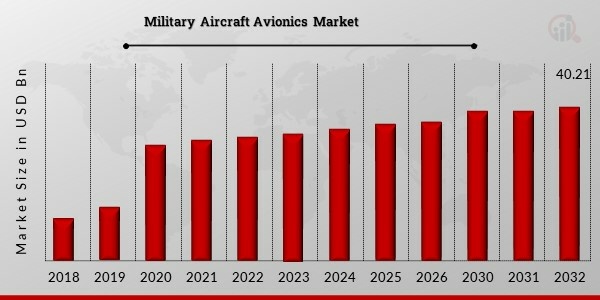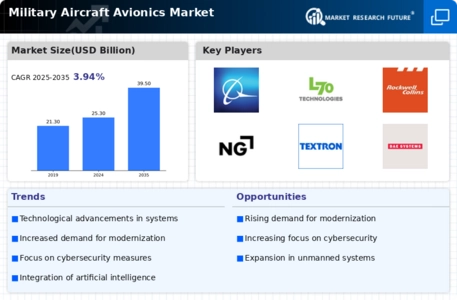Top Industry Leaders in the Military Aircraft Avionics Market

Strategies Adopted By Key Players military aircraft avionics market
Hilton Software (US),
Curtiss-Wright (US),
ENSCO Avionics (US),
Avidyne (US),
Honeywell (US),
Thales Group (France),
Xavion (US),
GE Aviation (US),
Rockwell Collins (US),
Aspen Avionics (US),
L-3 Avionics Systems (US),
Elbit Systems (Israel),
ForeFlight (US),
Sagetech (US),
Zodiac Aerospace (France).
Lockheed Martin Corporation stands out as a key player, leveraging its extensive experience and technological prowess to offer cutting-edge avionic solutions. The company's strategy revolves around continuous innovation and collaboration with defense organizations worldwide. Northrop Grumman Corporation, another major player, focuses on developing integrated avionics systems, emphasizing the importance of seamless communication and interoperability among various aircraft systems.
BAE Systems plc is a notable competitor, emphasizing the integration of artificial intelligence and machine learning in avionics to enhance decision-making capabilities. Thales Group, with its global presence, has been at the forefront of providing avionic solutions that prioritize connectivity and data sharing for enhanced situational awareness. Raytheon Technologies Corporation, formed through a merger of Raytheon Company and United Technologies Corporation, is a powerhouse in avionics, leveraging its comprehensive portfolio to cater to diverse military requirements.
The strategies adopted by these key players revolve around research and development, strategic partnerships, and mergers and acquisitions. Research and development initiatives play a crucial role in staying ahead in the competitive landscape. Companies invest significantly in developing advanced avionics technologies, including radar systems, communication systems, navigation systems, and electronic warfare systems. These innovations are geared towards meeting the evolving needs of modern military operations, offering enhanced performance, reliability, and security.
Strategic partnerships and collaborations are another cornerstone of the competitive landscape. Companies often join forces with other defense contractors, technology firms, or academic institutions to pool resources and expertise. Such collaborations enable the development of integrated avionic solutions that address the complex challenges faced by military aircraft. Mergers and acquisitions are also prevalent, allowing companies to expand their product offerings, enter new markets, and strengthen their overall market position.
Factors contributing to market share analysis in the military aircraft avionics sector include technological capabilities, product performance, reliability, cost-effectiveness, and the ability to meet specific military requirements. Companies that excel in these aspects are better positioned to secure contracts and partnerships with defense organizations globally. Additionally, compliance with stringent safety and security standards, along with the ability to adapt to evolving cybersecurity threats, is crucial for maintaining a competitive edge.
Emerging Companies
In recent years, new and emerging companies have entered the military aircraft avionics market, contributing to increased competition. These companies often bring fresh perspectives and innovative solutions, challenging established players. One such emerging trend is the integration of artificial intelligence, machine learning, and data analytics into avionics systems to enhance decision-making and mission capabilities. Start-ups focusing on these technologies have gained attention and are gradually disrupting the traditional avionics landscape.
Industry news and developments shape the competitive scenario, reflecting the dynamic nature of the military aircraft avionics market. News regarding successful contract awards, product launches, and technological breakthroughs significantly impact the perception of companies in the market. Additionally, geopolitical events, changes in defense budgets, and evolving security threats influence the strategic decisions of key players, shaping the overall competitive landscape.
Current company investment trends in the military aircraft avionics market indicate a continued focus on research and development, with a particular emphasis on emerging technologies. Investments in cybersecurity measures are also on the rise, as the threat landscape becomes more sophisticated. Companies are allocating resources to ensure that their avionic systems are resilient against cyber threats, ensuring the integrity and confidentiality of sensitive military information.
In conclusion, the competitive landscape of the military aircraft avionics market is marked by intense competition, technological advancements, and strategic maneuvers by key players. Lockheed Martin Corporation, Northrop Grumman Corporation, BAE Systems plc, Thales Group, and Raytheon Technologies Corporation lead the industry, leveraging their expertise and capabilities to offer cutting-edge avionic solutions. The strategies adopted by these companies include research and development, strategic partnerships, and mergers and acquisitions. Factors for market share analysis include technological capabilities, product performance, reliability, cost-effectiveness, and compliance with safety and security standards. The entry of new and emerging companies, industry news, and current investment trends contribute to the dynamic and evolving nature of the competitive scenario in the military aircraft avionics market.
Recent News :
The market is witnessing a constant evolution as nations invest heavily in modernizing their defense capabilities, leading to a surge in demand for advanced avionic systems. Several key players dominate this landscape, including Lockheed Martin Corporation, Northrop Grumman Corporation, BAE Systems plc, Thales Group, and Raytheon Technologies Corporation. These industry giants continually engage in research and development activities to enhance their product portfolios and maintain a strong foothold in the market.










